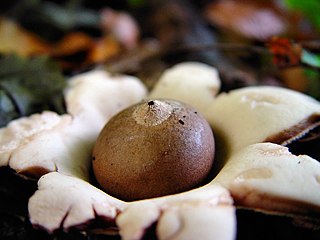
Geastrales is an order of gasterocarpic basidiomycetes (fungi) that are related to Cantharellales. The order contains the single family Geastraceae, which includes the "earthstars" formerly placed in Lycoperdales, or Phallales.

Lewis David de Schweinitz was a German-American botanist and mycologist from Bethlehem, Pennsylvania. Considered the "Father of North American Mycology," he also made significant contributions to botany.

Geastrum is a genus of puffball-like mushrooms in the family Geastraceae. Many species are commonly known as earthstars.
Geastrum berkeleyi, or Berkeley's earthstar, is an inedible species of mushroom belonging to the genus Geastrum, or earthstar fungi. It can be distinguished from other Geastrum species by the flat bipyramidal shape of the calcium oxalate crystals found on its endoperidium.

Geastrum campestre is an inedible species of mushroom belonging to the genus Geastrum, or earthstar fungi.
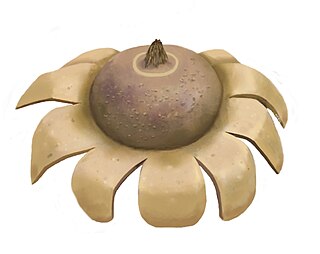
Geastrum corollinum is an inedible species of mushroom belonging to the genus Geastrum, or earthstar fungi. First described scientifically by German naturalist August Johann Georg Karl Batsch in 1792 as Lycoperdon corollinum, it was transferred to the genus Geastrum by László Hollós in 1904.
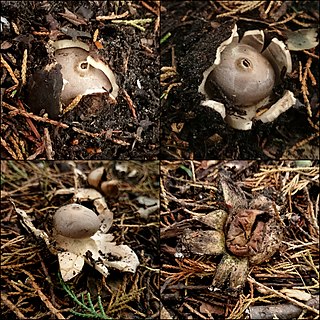
Geastrum coronatum is an inedible species of mushroom belonging to the genus Geastrum, or earthstar fungi. Christian Hendrik Persoon published the first description of Geastrum coronatum in 1801.

Geastrum pectinatum is an inedible species of mushroom belonging to the earthstar family of fungi. Although young specimens are spherical, fruit body development involves the outer layer of tissue splitting open like a star into 7 to 10 pointed rays that eventually bend back to point downward, revealing a small – 1 to 2.5 cm broad – spore sac. The spore sac is supported by a small radially wrinkled stalk. There is a distinct conical opening (peristome) at the top of the spore sac that is up to 8 mm long. It is commonly known as the beaked earthstar or the beret earthstar, in reference to the shape of the spore sac and its prominent, protruding peristome. The mass of spores and surrounding cells within the sac, the gleba, is dark-brown, and becomes powdery in mature specimens. Spores are spherical, measuring 4 to 6 micrometers in diameter, with warts on their surfaces.

Astraeus hygrometricus, commonly known as the hygroscopic earthstar, the barometer earthstar, or the false earthstar, is a species of fungus in the family Diplocystaceae. Young specimens resemble a puffball when unopened. In maturity, the mushroom displays the characteristic earthstar shape that is a result of the outer layer of fruit body tissue splitting open in a star-like manner. The false earthstar is an ectomycorrhizal species that grows in association with various trees, especially in sandy soils. A. hygrometricus was previously thought to have a cosmopolitan distribution, though it is now thought to be restricted to Southern Europe, and Astraeus are common in temperate and tropical regions. Its common names refer to the fact that it is hygroscopic (water-absorbing) and can open up its rays to expose the spore sac in response to increased humidity, then close them up again in drier conditions. The rays have an irregularly cracked surface, while the spore case is pale brown and smooth with an irregular slit or tear at the top. The gleba is white initially, but turns brown and powdery when the spores mature. The spores are reddish-brown and roughly spherical with minute warts, measuring 7.5–11 micrometers in diameter.

Astraeus is a genus of fungi in the family Diplocystaceae. The genus, which has a cosmopolitan distribution, contains nine species of earthstar mushroom. They are distinguished by the outer layer of flesh (exoperidium) that at maturity splits open in a star-shape manner to reveal a round spore sac. Additionally, they have a strongly hygroscopic character—the rays will open when moist, but when hot and dry will close to protect the spore sac. Species of Astraeus grow on the ground in ectomycorrhizal associations with trees and shrubs. Despite their similar appearance to the Geastrum earthstars Astraeus is not closely related.

Geastrum triplex is a fungus found in the detritus and leaf litter of hardwood forests around the world. It is commonly known as the collared earthstar, the saucered earthstar, or the triple earthstar—and less commonly by the alternative species name Geastrum indicum. It is the largest member of the genus Geastrum and expanded mature specimens can reach a tip-to-tip length of up to 12 centimeters.
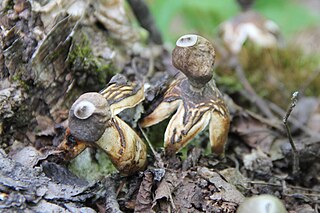
Geastrum quadrifidum, commonly known as the rayed earthstar or four-footed earthstar, is an inedible species of mushroom belonging to the genus Geastrum, or earthstar fungi. First described scientifically by Christian Hendrik Persoon in 1794, G. quadrifidum is a cosmopolitan—but not common—species of Europe, the Americas, Africa, Asia, and Australasia. The fungus is a saprobe, feeding off decomposing organic matter present in the soil and litter of coniferous forests.

Geastrum welwitschii is a species of fungus in the earthstar family. First collected from Spain in the mid-19th century, the fungus is distributed in Europe, North America, and Bermuda.

František Kotlaba was a Czech botanist and mycologist.
Andrew Price Morgan was an American botanist. He investigated the flora of the Miami Valley in Ohio. While his interest included flowering plants, as noted by his Flora of the Miami Valley, Ohio, his special interest was in fungi. Morgan worked as a teacher in Dayton. He studied the botany of the Great Miami River, publishing in 1878 the Flora of the Miami River, Ohio; Morgan also showed particular interest in mycology and bryology. A.P. Morgan was a mentor to the prominent American mycologist Curtis Gates Lloyd. His correspondence with Lloyd is stored in the Lloyd Library and Museum in Cincinnati. Lloyds portion of the correspondence is stored in the Ada Hayden Herbarium at Iowa state university. Morgans collection of preserved fungi can also be found at the Ada Hayden Herbarium along with Laura Morgans gouache illustrations of fungi that could not be preserved.

Geastrum minimum, the tiny earthstar, is an inedible species of mushroom belonging to the genus Geastrum. Although rare, it is widespread in Europe, where it occurs in a range of habitats. It is a priority species in the UK, where it has been found in the sand dunes at Holkham National Nature Reserve.

Sarcodon atroviridis is a species of fungus in the family Bankeraceae found in North America and Asia. It was originally described in 1895 as Hydnum atroviride by Andrew Price Morgan. Howard James Banker transferred it to Sarcodon in 1906. The fungus is known from Asia and North America; in 2015 it was reported from Brazil. The specific epithet atroviridis means "blackish green". While not explicitly known to be poisonous, it is considered of poor edibility.

Geastrum rufescens, commonly known as the rosy earthstar, is a species of fungus in the family Geastraceae. It was first described scientifically by Christian Hendrik Persoon in 1801. It has a pale pinkish-buff to pinkish exoperidium and rays. The earthstar is found in Europe, North America, and Japan, where it typically grows at the base of old oak stumps.
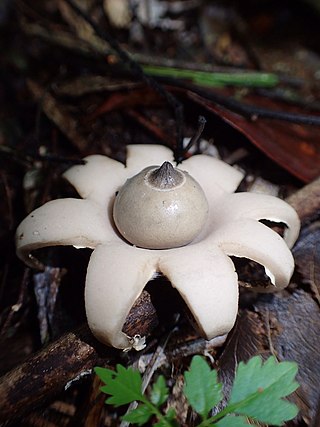
Geastrum lageniforme is a species of fungus belonging to the genus Geastrum. It was described as new to science by Italian mycologist Carlo Vittadini. It is found in Africa, Europe, North America, and South America.
















